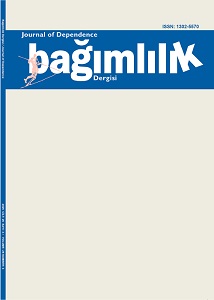THE RELİABİLİTY AND VALİDİTY OF TURKİSH VERSİON OF DSM-5 LEVEL 2 SUBSTANCE USE DİSORDER SCALE
Keywords:
DSM-5 Level 2 Substance Use Disorder Scale, reliability, validityAbstract
Objective: In this study, it was aimed to assess the validity and reliability of Turkish version of DSM-5 Level 2 Substance Use Disorder Scale.
Methods: Study groups consisted of a clinical sample diagnosed with substance use disorder being treated in a child psychiatry unit and a community sample. A total number of 92 parents and 128 adolescents were included in the study. Clinical sample consisted of 34 adolescents between 11-17 years old that were diagnosed with substance use disorder according to DSM-5 diagnostic criteria and being followed up in Celal Bayar University Medical School Child Psychiatry Unit and Alcohol and Substance Treatment Unit for Children and Adolescents of Tepecik Research and Training Hospital and 33 parents. Addiction Profile Index for Adolescents (BAPI) form was used alongwith DSM-5 Level 2 Substance Use Disorder Scale for assessment. For reliability analyses, internal consistency coefficient and item-total score correlation analysis were carried out; concurrent validity was measured for validity analyses as well as developing ROC curve to identify discriminative quality of the scale regarding clinical and community samples.
Results: Cronbach alpha internal consistency coefficient was found as 0.847 and 0.760 for child and parent forms, respectively. Regarding concurrent validity, correlation of the scale’s child form with BAPI- Adolescent form was 0.742. Area under the ROC curve as a result of ROC analysis yielded a measure of 0.964 for child form and 0.990 for parent form.
Conclusion: Results indicate that DSM-5 Level 2 Substance Use Disorder Scale- Turkish Version could be utilized as a valid and reliable instrument for both clinical and research purposes.
References
Yule AM, Jefferson B, Prince JB. Evidence-based school psychiatry adolescent subtance use disorders in the school setting. Child Adolesc Psychiatr Clin N Am 2012; 21:175-86.
Merikangas KR, He JP, Burstein M, et al. Life-time prevalence of mental disorders in US adolescents: Results from the National Co-morbidity Survey Replication—Adolescent Supplementation (NCS-A). J Am Acad Child Adolesc Psychiatry 2010; 49: 980–9.
Johnston LD, O’Malley PM, Bachman JG, et al. Monitoring the future national results on adolescent drug use: overview of key find-ings, 2010. Ann Arbor (MI): Institute for Social Research, The University of Michigan, 2010.
Ögel K, Taner S, Eke CY, Onuncu sınıf öğrencileri arasında tütün, alkol ve madde kullanım yaygınlığı: İstanbul örneklemi. Bağımlılık Dergisi 2006; 7: 18-23.
Sanchez-Samper X, Knight JR. Drug abuse by adolescents: General considerations. Pediatr Rev 2009; 30: 83–93.
Dawson DA, Goldstein RB, Chou SP, et al. Age at first drink and the first incidence of adult-onset DSM-IV alcohol use disorders. Alcohol Clin Exp Res 2008; 32: 2149–60.
Lynskey MT, Agrawal A, Heath AC. Genetically informative research on adolescent substance use: Methods, findings, and challenges. J Am Acad Child Adolesc Psychiatry 2010; 49: 1202–14.
Amerikan Psikiyatri Birliği. Ruhsal Bozuklukların Tanısal ve Sayımsal Elkitabı, Beşinci Baskı (DSM-5). Tanı Ölçütleri Başvuru Elkitabı, Köroğlu E (Çeviren). Ankara: Hekimler Yayın Birliği, 2013
Online Assessment Measures. http://www.psychiatry.org/practice/dsm/dsm5/online-assessment-measures
Ögel K, Evren C, Karadağ F, Gürol DT. Bağımlılık profil indeksi’nin (BAPİ) geliştirilmesi, geçerlik ve güvenilirliği. Türk Psikiyatri Dergisi 2012; 23: 264-73
Ögel K, Aksoy A, Topuz A, ve ark. Ergenlerde uçucu madde kullanımı şiddetini değerlendirme ölçeğinin geliştirilmesi ve güvenilirlik çalışması. Türk Psikiyatri Dergisi 2005; 16: 260-267
Kandemir H, Aydemir Ö, Ekinci S, et al. Va-lidity and reliability of the Turkish version of CRAFFT substance abuse screening test among adolescents. Neuropsychiatric Dis-ease and Treatment 2015; 11: 1505–1509.
Evren C, Can Y, Yılmaz A, ve ark. Psychomet-ric properties of the Drug Abuse Screening Test (DAST-10) in heroin dependent adults and adolescents with drug use disorder. Düşünen Adam Journal of Psychiatry and Neurological Sciences 2013; 26: 351-359
Evren C, Ovalı E, Karabulut V, ve ark. Psychometric properties of the Drug Use Disorders Identification Test (DUDIT) with heroin dependent adults and adolescents with drug use disorder. Bulletin of Clinical Psychopharmacology 2014; 24: 39-48
Aydemir Ö, Köroğlu E .Psikiyatride kullanılan Klinik Ölçekler. Ankara: Hekimler Yayın Birliği, 2000
Aktürk, Z, Acemoğlu H. Sağlık Çalışanları için Araştırma ve Pratik İstatistik, Örnek Problemler ve SPSS çözümleri, 2007. http://tipegitimi.atauni.edu.tr/userfiles/ files/istatistikKitapBaski2_s16.pdf
Downloads
Published
How to Cite
Issue
Section
License
Copyright (c) 2025 Journal of Dependence

This work is licensed under a Creative Commons Attribution-NonCommercial-NoDerivatives 4.0 International License.
...
